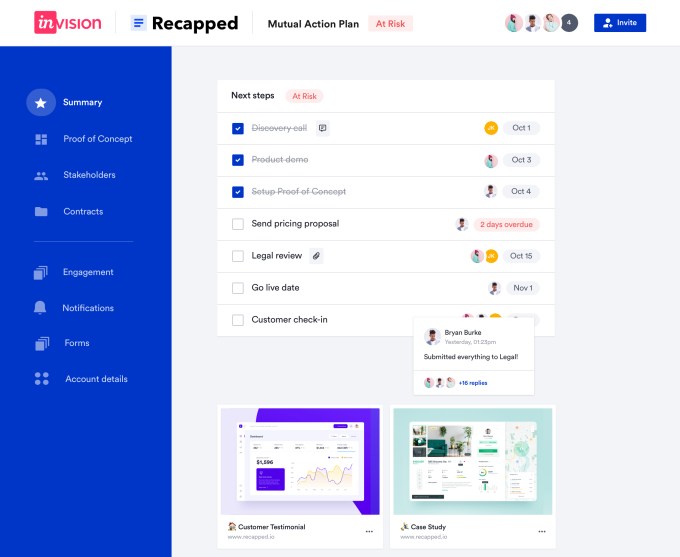- July 19, 2021
- by:
- in: Blog
Online learning continues to see a huge boost of attention and use in the wake of the Covid-19 pandemic, and today a startup building tools specifically for enterprises to deliver on their internal education remits is announcing a big round of funding that points to the startup’s own growth and ambitions. Go1, which provides curated
Online learning continues to see a huge boost of attention and use in the wake of the Covid-19 pandemic, and today a startup building tools specifically for enterprises to deliver on their internal education remits is announcing a big round of funding that points to the startup’s own growth and ambitions.
Go1, which provides curated online learning materials and tools to businesses, with “playlists” that tap content from multiple publishers and silos, has closed a round of $200 million, a Series D that the Australian company’s CEO and co-founder confirmed values the startup at over $1 billion.
Barnes added that the funding will be used to expand further in existing markets — based out of Brisbane, Australia, Go1 has offices in London, the U.S., Singapore and Malaysia, so it wants to go deeper into Europe more broadly and into more of Asia Pacific, he said. Go1 will also continue expanding its suite of services in the wider areas of learning and development training, he added.
Today, it already offers a host of analytics and AI tech to chart how well that content is used and to further personalize materials, so the idea will be to expand on that more.
SoftBank’s Vision Fund 2, AirTree Ventures and Salesforce Ventures co-led this Series D, with Blue Cloud Ventures, Larsen Ventures, Madrona Venture Group, Microsoft’s M12, SEEK, TEN13, and Tiger Global also participating. (To be clear it appears that there were reports about this Series D closing but no details on the value, the investors, nor confirmation from the company.)
The funding represents a major capital infusion for the startup: prior to this it had only raised about $80 million over the last six years, with the last round, a more modest Series C of $40 million, closed 14 months ago.
But it also comes on the heels of impressive growth. Incubated at Y Combinator and based out of Brisbane, Australia, the company currently works with some 3.5 million users and over 1,600 enterprises globally, with companies like Microsoft, TikTok, the University of Oxford, Suzuki, Asahi and Thrifty, as well as many small businesses, among its customers. On average, an individual, when actively engaging on Go1, spends between two and six hours per month using the platform, and Barnes told me that its user base has growth by more than 300 percent in the last year.
But in a tech world now full of options for online learning content — both for K-12 as well as business users — what is perhaps more interesting is the startup’s approach.
Currently, Go1 has some 150,000 pieces of content available in its library, but it has not created any of that itself. The material comes from some 1,000 publishers and creators, a figure that is growing weekly, said Barnes, and includes not just your standard names in online education like Pearson, EdX, Coursera and Skillsoft, but also Blinkist and the Harvard Business Review.
The point of Go1 is to make it easier for businesses to access and use all these materials without having to negotiate separate deals with the various rights holders, or for users to have to negotiate multiple apps or sites to use it.
Somewhat akin to a streaming service like Spotify, Go1 acts not just as a distributor/aggregator to access that content, but as a channel for those providers, who receive royalties based on how much their content is consumed. (And individual rights holders can also negotiate how some or all of their content is accessed, in the event that they have paywalls that they do not want to break down in specific areas.)
The Spotify analogy goes beyond the company’s business model: Barnes pointed out that it too calls its curated bundles — which it creates itself, or lets customer create themselves — “playlists.”
“We stated the business six years ago because no one else was doing this, yet there was such a desire to bring together that diversity of content and make it easily available,” he said.
The challenge for employers is not just the user experience of navigating multiple sites (which Go1 solves with these curated playlists), but also to build learning that is still cohesive and easy to manage, regardless of which department or employee is doing the training. “How do I create something for the broad diversity of skills for our workforce?” is how Barnes described it to me. This is what the company addresses with the platform, he added, not only making it easier to create training for different people, but to find relevant content that will interest those users by offering as big a selection as possible. “We help people find the needle in the haystack.”
Where the analogy stops, it seems, is in how Go1 interfaces with the rest of the corporate learning market.
I asked Barnes if he saw companies like Success Factors as competitors, but in reality, Go1’s ethos is to integrate into whatever education or training platform a company might already use, be it SAP, Workday, Salesforce or Microsoft-based platforms, or something else altogether.
Borrowing another media comparison, Barnes notes that he sees Go1 as occupying the “Netflix” button on a remote: regardless of the manufacturer or pay-TV provider, you still have a way to get your Netflix fix; and so, too, is the hope for Go1 in corporate learning and development training.
This also means that while platforms are not rivals, others also aggregating content might well be: that likely makes for an interesting relationship with Microsoft, given that it owns LinkedIn, which has LinkedIn Learning, which also aggregates content from across a wide range of publishers. It seems that while Microsoft has slowly created more integrations with LinkedIn over the years since it’s acquired it, this is one area where it’s also been okay with working with one of its competitors.
“Our team worked closely with Go1 on a Microsoft Teams integration to enable more enterprises to maintain corporate training remotely,” said Jeff Teper, Microsoft Corporate Vice President, Teams, OneDrive, SharePoint, said in a statement. “As many companies navigate in-person work scenarios, a plan for hybrid engagement is critical. Employees and students can access one of the world’s largest libraries of online learning resources with Go1 in Microsoft Teams. Companies can also onboard new talent and ensure essential trainings are provided regardless of employee location.”
One way that Go1 is looking to grow is in how it is used by the individuals that learn or train on its platform.
Another reason Barnes and his co-founders — Vu Tran (head of growth), Chris Eigeland (now CRO), and Chris Hood (CTO) — started Go1, he said, was because of a pain point one of them directly encountered. Tran was doing his training to become a doctor at the time, and he found it very frustrating that he had re-do hand washing training each time he started a new rotation.
“There was no way to reshare that he’d already done that,” Barnes said. Go1 is trying to double down on that, increasing the ability for its users to “own” those credentials and certifications and re-use them in subsequent places, even when they change jobs. (Again… not unlike exporting a Spotify playlist, which you can also do.)
It seems that I am not the only one who sees a lot of Spotify resonance in Go1.
“When people think about music, they often think of Spotify and access to unlimited music for one subscription. We believe Go1 is the emerging category leader in providing a similar experience for corporate learning. Powered by AI and machine learning, Go1’s platform provides an intuitive experience, and creates an opportunity for individuals to expand their professional development goals and explore the resources to help achieve them,” said Nagraj Kashyap, managing partner at SoftBank Investment Advisers, in a statement.







